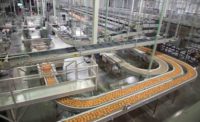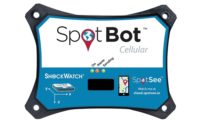As snack and bakery producers integrate more refrigerated and frozen foods into their production and distribution lineup, suppliers serving the industry continue to develop innovative ways to monitor the cold chain, improving safety and streamlining requisite needs for traceability. These innovations help snack producers and bakeries tackle a wide range of challenges they face on a regular basis. (For more insights into current cold chain logistics, see “Advances in cold chain technology for snack and bakery warehousing and transport.”)
“The challenge in the cold chain for frozen and refrigerated snacks is making sure all of the adjacent events within the cold chain are truly cold-holding products,” explains Ted Wilkes, director of business development, BluLine Solutions, Pittsburgh. Another challenge is interfacing the temperature data to your own ERP or CRM system for permanent record-keeping for the FSMA act, and to prove complete change of custody, he says.
“A cloud-based temperature-monitoring system simplifies this, because it provides all the data hooks to offer a full transparent view of the captured data. Blulog’s BluConsole comes with an API that allows ease of data integration into ERP/CRM software applications that our customers use. That means many Blulog customers can provide proof immediately to their own customers if the cold chain responsibility was ever challenged,” Wilkes adds.
Another major challenge is shipping the products at the correct temperatures and making sure those temperatures do not fluctuate. If the temperature fluctuates or the cold storage fails, then thousands of dollars of product could be lost—or even worse, contaminated—says Mary Vessele, product marketing manager, test and measurement, Cole-Parmer, Vernon Hills, IL. “Using products like the Digi-Sense TraceableOne Single-Use USB Temperature Data Logger or the Digi-Sense Data Loggers with TraceableGO Bluetooth Capability can help monitor the temperature during transport, taking the guesswork and worry out of this part of the cold chain process,” she notes.
Amy Childress, vice president of marketing and planning, cargo solutions, Emerson, St. Louis, says that challenges Emerson hears about from customers include food safety, food quality and regulations. “With one in six Americans contracting foodborne illnesses each year, one 250-person outbreak has the potential to cost a fast-food restaurant up to $1.9 million,” she remarks. “The responsibility to ensure food safety not only falls on the end users (restaurant/retail), it also falls on the harvesting, processing, transporting and distributing phases of the cold chain.”
In a rapidly changing world where seemingly everything is interdependent and interconnected, commercial and regulatory demands are driving significant changes throughout the cold chain, Childress adds. “These changes are dictating a much more tightly controlled, regulated and monitored environment for operations. About 80 percent of food shipments in the U.S. are handled by smaller transport companies with a fleet of five or fewer trucks, making it difficult for them to make the investments necessary to meet federal regulations.” Partnering with the right supply-chain partner can help smaller snack and bakery businesses comply without the need to make costly investments in their own equipment, she suggests.
“People often believe frozen foods are impervious to food quality and safety incidents because they are frozen. However, these goods are susceptible to the same cold chain issues as refrigerated foods, and should be similarly managed and monitored,” Childress says.
“Food suppliers need to use proper refrigeration throughout the entire cold chain and implement a HACCP strategy to manage the cold chain and ensure food safety,” says Rob Fusco, director of business development, Sensaphone, Ashton, PA. To overcome this challenge, he recommends using remote monitoring systems, which are inexpensive, and easy to install and maintain. They’re a cost-effective way to maintain the integrity of the cold chain, he says.
Controlling temperature is much more difficult once a product leaves storage to be transported, says Bruce Gaydos, director of sales for North America, SpotSee, Dallas. “The biggest challenge is ensuring proper temperatures are maintained when products change hands and while traveling in the last mile. Cross-docking or having multiple stops before reaching a product’s destination also present major challenges for suppliers and distributors,” he explains.
If temperatures fluctuate, a product may now have a shorter shelf life, have its appearance ruined or spoil outright. That can either be due to a period of delayed storage at the point of delivery, such as to a retail grocery store. These challenges can be mitigated and identified with the inclusion of temperature-monitoring devices, Gaydos notes.
Challenges are broadly the same across all perishable food segments, namely a lack of control and visibility as shipments move from origin to destination, especially at the multiple points where hand-offs occur, such as loading cargo to and from warehouses and trainers or containers, says Sue Rutherford, vice president, marketing, ORBCOMM, Rochelle Park, NJ. “No single entity controls the entire cold chain, generally speaking, so there are many chances for breakdowns. While we call it a cold chain, it is in fact a series of siloed processes—or has been, historically—with a lack of robust information, communication and collaboration between the different parties.
“The efforts taking place now are to harness digital technology to break down those ‘silos,’” continues Rutherford. “We are already moving to the next state of telematics deployment in the shape of advanced analytics that allow users to mine all of their IoT data and detect trends and patterns invisible to the human eye that can then be used to predict and manage future outcomes.”
Another big challenge is compliance, says Carissa Smith, marketing director, American Thermal Instruments, Dayton, OH. “Compliance is a major challenge within the food industry. Depending on the stage of the process, there are a number of temperature regulations—HACCP, FSMA, etc.—from manufacturing/processing, to shipment and storage. Time tends to play a large role in food quality, too—most food products have to be kept to a certain temperature for a certain amount of time to degrade or become unsafe,” she explains.
“We are utilizing a number of different technologies when it comes to our temperature monitoring devices. Our full line of temperature monitoring devices have a unique identifier and have the ability to be scanned via an app to push digital temperature data to a cloud repository. This allows temperature data at your fingertips—anytime and anywhere. Our solutions are scalable and easily integrated into various processes or systems,” Smith states.
As cold chain technology continues to grow and improve, it will be easier to trace products throughout the chain.
“We are absolutely seeing growth in demand for cold chain telematics to satisfy demand from all quarters for basic traceability, improved food safety, regulatory compliance—such as FSMA—quality control, cargo care and supply-chain efficiency,” says Rutherford. “It is no longer acceptable for perishable products to drop into a ‘black hole’ as they move from origin to destination.”
For more insights into snack and bakery cold chain logistics, see “Advances in cold chain technology for snack and bakery warehousing and transport.”





